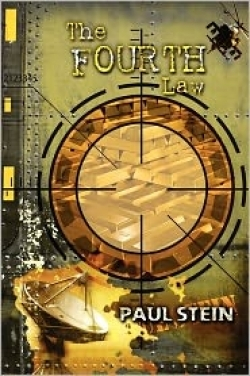The Fourth Law
Paul Stein’s first novel, The Fourth Law, encompasses blood rivalry, physics, high-tech robbery, villains with schemes worthy of James Bond, and the power of family, love, God, and forgiveness.
University scientist Jarrod Conrad researches feverishly in an attempt to discover the fourth law, a unifying theorem of all physics, which will allow him to perfect a machine that makes objects float—an anti-gravity machine. He has a longstanding feud with his cousin Ryan Marshall, a construction engineer who owns a company called Levitation Solutions. Marshall, too, has been trying to put his structures in a perfect state of suspension. An avaricious criminal genius, Alistair Holloway, and his mercenaries steal Conrad’s blueprints so the gang can use the anti-gravity machine to purloin gold bullion from Fort Knox. Part of Holloway’s plan, however, is to make the cousins suspect each other of sabotage. Conrad and Marshall eventually realize someone is toying with them and that they must cooperate to thwart Holloway.
This novel is told from multiple points of view: from Conrad, Marshall, Holloway, various mercenaries and love interests, as well as from those of minor characters who appear only once or twice. This results in readers getting to know all characters as multi-faceted human beings and therefore caring about them. This multi-perspective allows the audience to empathize with Holloway’s goons, for example. Although they are motivated by greed, these henchmen have identities and dreams not linked to Holloway. Because the audience becomes intimately acquainted with every character, there is a sense of loss when the character is painstakingly built up, only to die right after introduction or hardly end up being referred to after their initial chapter. Furthermore, Stein’s science, even that of the anti-gravity machine, appears meticulous and credible. In fact, the author provides so much detail about everything from airplanes to guns to physics that the uninitiated may get lost in the deluge of details. Stein also creates rich, interesting backstories about the immigrant ancestors of Conrad and Marshall. Sometimes, though, the author spends an inordinate amount of time in the past, which takes readers away from the story’s present.
Stein also has a propensity to tell instead of show. Readers are told in great detail about the cousins’ animosity that dates from childhood, but not enough information is given on the hateful acts of their youth to justify their mutual rancor. The author additionally relies on stereotypes: the henpecked wife, the pitiable disabled child, the virginal pious beauty, the unattractive scientist, to name a few. The characters rivalry of their youth makes little mention of the boy’s relationship with God. At the end, however, Marshall and Conrad start invoking the Lord’s name with a fervor that seems out of place.
Stein also occasionally commits errors in usage and punctuation. More distracting, however, is the appearance of the font on the page. The first paragraph of each chapter has a much bigger typeface than the following paragraphs. Stein’s use of large paragraphs often results in the font on the first page of each chapter being large. Within chapters, too, the text size and line spacing fluctuates, causing the readers’ eyes to jump.
The Fourth Law marks an ambitious and mostly successful debut.
Reviewed by
Jill Allen
Disclosure: This article is not an endorsement, but a review. The publisher of this book provided free copies of the book and paid a small fee to have their book reviewed by a professional reviewer. Foreword Reviews and Clarion Reviews make no guarantee that the publisher will receive a positive review. Foreword Magazine, Inc. is disclosing this in accordance with the Federal Trade Commission’s 16 CFR, Part 255.

